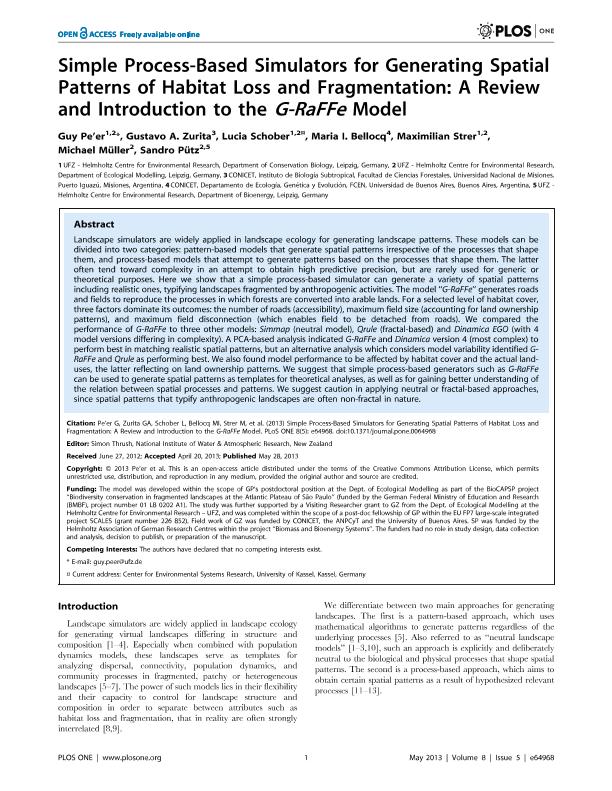Mostrar el registro sencillo del ítem
dc.contributor.author
Pe’er, Guy
dc.contributor.author
Zurita, Gustavo Andres

dc.contributor.author
Schober, Lucía
dc.contributor.author
Bellocq, Maria Isabel

dc.contributor.author
Strer, Maximilian
dc.contributor.author
Muller, Michael
dc.contributor.author
Putz, Sandro
dc.date.available
2017-10-10T17:15:43Z
dc.date.issued
2013-05
dc.identifier.citation
Pe’er, Guy; Zurita, Gustavo Andres; Schober, Lucía; Bellocq, Maria Isabel; Strer, Maximilian; et al.; Simple process-based simulators for generating spatial patterns of habitat loss and fragmentation: a review and introduction to the G-RaFFe model; Public Library Science; Plos One; 8; 5; 5-2013; 1-14; e64968
dc.identifier.uri
http://hdl.handle.net/11336/26386
dc.description.abstract
Landscape simulators are widely applied in landscape ecology for generating landscape patterns. These models can be divided into two categories: pattern-based models that generate spatial patterns irrespective of the processes that shape them, and process-based models that attempt to generate patterns based on the processes that shape them. The latter often tend toward complexity in an attempt to obtain high predictive precision, but are rarely used for generic or theoretical purposes. Here we show that a simple process-based simulator can generate a variety of spatial patterns including realistic ones, typifying landscapes fragmented by anthropogenic activities. The model ‘‘G-RaFFe’’ generates roads and fields to reproduce the processes in which forests are converted into arable lands. For a selected level of habitat cover, three factors dominate its outcomes: the number of roads (accessibility), maximum field size (accounting for land ownership patterns), and maximum field disconnection (which enables field to be detached from roads). We compared the performance of G-RaFFe to three other models: Simmap (neutral model), Qrule (fractal-based) and Dinamica EGO (with 4 model versions differing in complexity). A PCA-based analysis indicated G-RaFFe and Dinamica version 4 (most complex) to perform best in matching realistic spatial patterns, but an alternative analysis which considers model variability identified GRaFFe and Qrule as performing best. We also found model performance to be affected by habitat cover and the actual landuses, the latter reflecting on land ownership patterns. We suggest that simple process-based generators such as G-RaFFe can be used to generate spatial patterns as templates for theoretical analyses, as well as for gaining better understanding of the relation between spatial processes and patterns. We suggest caution in applying neutral or fractal-based approaches, since spatial patterns that typify anthropogenic landscapes are often non-fractal in nature.
dc.format
application/pdf
dc.language.iso
eng
dc.publisher
Public Library Science

dc.rights
info:eu-repo/semantics/openAccess
dc.rights.uri
https://creativecommons.org/licenses/by-nc-sa/2.5/ar/
dc.subject
Atlantic Forest
dc.subject
Simulator
dc.subject
Model
dc.subject.classification
Bioquímica y Biología Molecular

dc.subject.classification
Ciencias Biológicas

dc.subject.classification
CIENCIAS NATURALES Y EXACTAS

dc.title
Simple process-based simulators for generating spatial patterns of habitat loss and fragmentation: a review and introduction to the G-RaFFe model
dc.type
info:eu-repo/semantics/article
dc.type
info:ar-repo/semantics/artículo
dc.type
info:eu-repo/semantics/publishedVersion
dc.date.updated
2015-05-22T14:11:56Z
dc.identifier.eissn
1932-6203
dc.journal.volume
8
dc.journal.number
5
dc.journal.pagination
1-14; e64968
dc.journal.pais
Estados Unidos

dc.journal.ciudad
San Francisco
dc.description.fil
Fil: Pe’er, Guy. Helmholtz Centre for Environmental Research; Alemania
dc.description.fil
Fil: Zurita, Gustavo Andres. Consejo Nacional de Investigaciones Científicas y Técnicas. Centro Científico Tecnológico Conicet - Nordeste. Instituto de Biología Subtropical. Universidad Nacional de Misiones. Instituto de Biología Subtropical; Argentina
dc.description.fil
Fil: Schober, Lucía. Helmholtz Centre for Environmental Research; Alemania
dc.description.fil
Fil: Bellocq, Maria Isabel. Universidad de Buenos Aires. Facultad de Ciencias Exactas y Naturales. Departamento de Ecología, Genética y Evolución; Argentina. Consejo Nacional de Investigaciones Científicas y Técnicas; Argentina
dc.description.fil
Fil: Strer, Maximilian. Helmholtz Centre for Environmental Research; Alemania
dc.description.fil
Fil: Muller, Michael. Helmholtz Centre for Environmental Research; Alemania
dc.description.fil
Fil: Putz, Sandro. Helmholtz Centre for Environmental Research; Alemania
dc.journal.title
Plos One

dc.relation.alternativeid
info:eu-repo/semantics/altIdentifier/doi/http://dx.doi.org/10.1371/journal.pone.0064968
dc.relation.alternativeid
info:eu-repo/semantics/altIdentifier/url/http://journals.plos.org/plosone/article?id=10.1371/journal.pone.0064968
Archivos asociados
